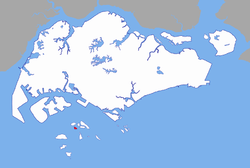Pulau Hantu
Coordinates: 1°13′34″N 103°45′00″E / 1.22611°N 103.75000°E
| Pulau Hantu/Ghost Island | |
|---|---|
| Name transcription(s) | |
| • Chinese | 韩都岛/鬼岛 |
| • Pinyin | hándū dǎo/guǐ dǎo |
| • Malay | Pulau Hantu |
| • Tamil | பேய் தீவு |
 | |
| Country |
|
| ► 1, 13, 34, N, 103, 43, 00, E | |
Pulau Hantu is located to the south of the main island of Singapore, off the Straits of Singapore. Pulau Hantu is actually made up of two islets: Pulau Hantu Besar (Big Ghost Island) and Pulau Hantu Kechil (Little Ghost Island), with a total area of 12.6 hectares. At low tide, it is possible to wade across the shallow lagoon between the two islands, but not at high tide.
Etymology
The name Pulau Hantu literally means "Ghost Island" in Malay.
It may refer to the "disappearing" moment of the mid part of the island during the high tide. During the low tide, Pulau Hantu can be seen as one island with two large bays on the northern and southern side of the island. However, during the high tide, the water level in the bays would rise and the midsection of island (which is geographically lower than other parts) would disappear under the tide and resulting in two smaller islands.

Legend
Pulau Hantu was where Malay warriors once duelled to the death and their ghosts are said to wander the island.
There were once two great warriors locked in a fierce battle at sea. Many people died and the blue seas slowly became polluted with human blood, upsetting the Jinns at the bottom of the ocean. In anger, one powerful Jinn created a whirlpool and sucked the two warriors into the deep sea to drown them. Not deterred, they continued their battle. Suddenly, the Jinn sprayed water on one of them. The other warrior, seeing his opponent blinded, thrust his sword into his abdomen. At the same time, the wounded warrior plunged his sword into the other man. Both collapsed and died.
The gods felt it was wrong for the sea spirits to interfere in human affairs. Thus, the Jinn transformed the two warriors into islets so that their spirits can continue to live on them. As one of the warriors was smaller than the other, his islet was known as Pulau Hantu Kecil while the bigger one was called Pulau Hantu Besar.
Current
Despite its forbidding name, Pulau Hantu is a favourite haunt for fishing, scuba diving and snorkeling enthusiasts because of its sheltered beaches, swimming lagoons and inviting waters. The islands are also popular with campers and day-trippers who prefer a unique outdoor experience.
Pulau Hantu has rich reefs despite its proximity to Pulau Bukom's refineries. A wide variety of corals can be found on Pulau Hantu, and mushroom corals are particularly abundant in the waters surrounding the islands. Common sea life that can also be found include the clown fish or anemonefish, damselfishes, wrasses and angelfish. The rare giant clam and the seahorse can sometimes be seen. There is a small patch of mangroves between Pulau Hantu Kecil and Pulau Hantu Besar, where native seashore plants also line their beaches.
Visibility, like most of Singapore's waters, is chronic, ranging from as low as 0.1 m to more than 3m.
It was reported in the June 3, 2006 edition of The Straits Times that a plan to create a "marine sanctuary" has been dropped due to opposition from conservationists. The plan, known as Project Noah, was to install mechanical filters at the two ends of the lagoon separating Pulau Hantu Kecil and Pulau Hantu Besar, to clear the waters of excess silt and pave the way for coral growth within the lagoon.
Coral Reef Surveys
The National Parks Board, National Biodiversity Centre, Blue Water Volunteers and volunteers from the public started a coral reef surveying programme in 2005 to monitor the status of hard corals, mobile invertebrates and reef fish at several locations around 5 southern islands, including Pulau Hantu.[1] Internationally recognised techniques developed by Reef Check and the Global Coral Reef Monitoring Network were adopted for this programme.
References
External links
| Library resources about Pulau Hantu |
- Pulau Hantu - A celebration of marine life A non-profit, environmental awareness initiative for Pulau Hantu, an island recognised by most divers as Singapore’s most popular Southern Island, known for its sheltered and biologically diverse reefs.
- Hantu Blogger's photostream
- Hantu Bloggers
- Info for visitors on wildsingapore
- Photos of Hantu's marine life on the intertidal from wildsingapore
- Blog posts about Hantu's marine life from various blogs compiled on the wildsingapore google reader
- Pulau Hantu Coral Reef Survey Data on Coral Reefs of Singapore
- Project NOAH sunk
- Satellite image of Pulau Hantu - Google Maps
| ||||||||||||||||||||||||||||||||||||